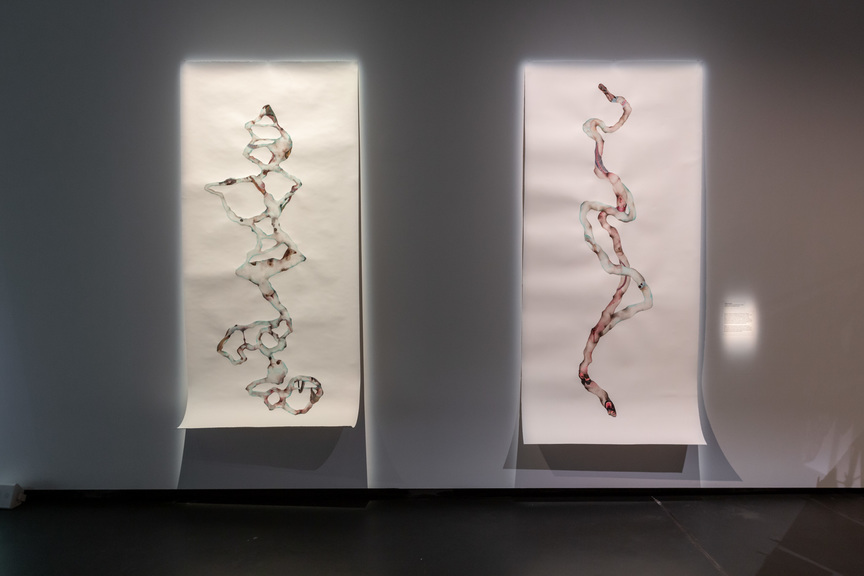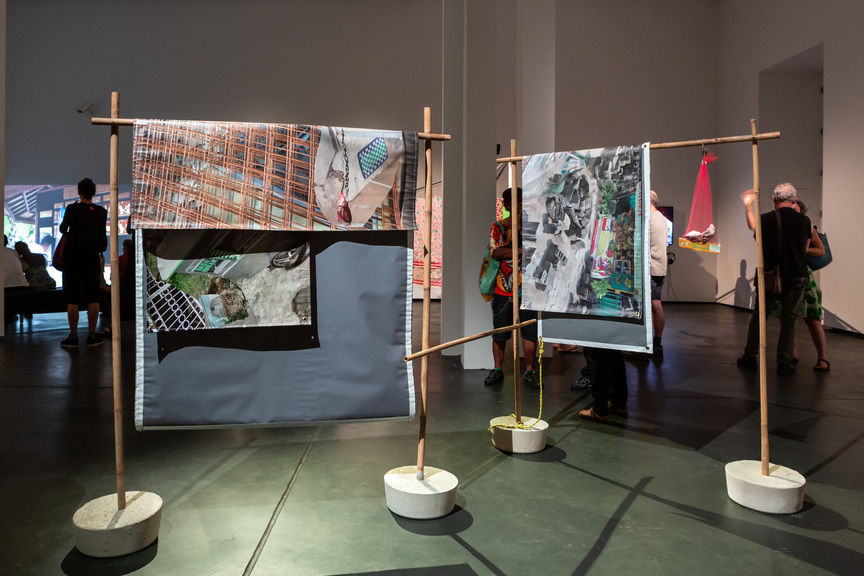-
From Current Issue
-
- Editor’s Letter Fire in the Heart
- Reviews I Gusti Ayu Kadek Murniasih
- Reviews 11th Seoul Mediacity Biennale: “One Escape at a Time”
- Dispatch Networked China
- One on One Monira Al Qadiri on Yukio Mishima
- Essays The rise of independent art spaces in pandemic-era Shanghai
- Features Tuan Andrew Nguyen
- Table of Contents
- Web Exclusives
- Archive
- Subscribe

R
E
V N
E
X
T
Installation view of “Looking Here Looking North” at the Casula Powerhouse Arts Centre, Sydney, 2019. Photo by Chantel Bann. Courtesy Casula Powerhouse Arts Centre.
At the Casula Powerhouse Arts Centre in Sydney, a video portrays the interior of a restaurant, its walls decorated with Australian-flag bunting, and kitsch Australiana tea towels and posters, positioning us inside an ostensibly Australian establishment. It is revealed in subsequent shots of the staff, clientele, and the beach outside, however, that this is in fact a tourist spot in Bali. Bridie Gillman’s video work Bali State of Mind (2017–18) ruminates on the unequal power dynamic between Australia and Indonesia, the latter being economically reliant on tourism and subject to the objectifying tourist gaze that comes with over one million Australians visiting annually.
Gillman is one of seven artists included in the exhibition “Looking Here Looking North” by members of Woven, a collective with “continuing personal connections to Indonesia.” While Gillman’s work is subtly political, the exhibition holistically was striking in its ability to reach beyond essentialist identity politics, reconfiguring what it means to be part of the Indonesian diaspora by speaking to universal themes of memory, place and belonging.
A poetic counterpoint to Gillman’s video is Sofiyah Ruqayah’s two-panel watercolor collage Whatever Makes You Cold Freezes Me (2018), inspired by the artist’s childhood memories of visiting the tomb of her ancestor Mbahrajapadumi in West Java. Ruqayah’s serpentine forms speak of lineage, bloodlines, congealed veins, and synapses, while the mottled texture evokes the corporeality of marked skin. Yet the medium of watercolor also embodies fluidity, mutability and ephemerality, representing the ever-changing nature of our own mnemonic identity and body. Ruqayah’s work serves as a microcosm for the multilayered exhibition itself: while bound by a study of diaspora, it also eludes it.
Similarly, Mashara Wachjudy’s work Konstruksi (2018), featuring collaged Google Street View images rebuilding the contours of her family kampong (village) in Bandung, printed onto banners and draped over bamboo structures, may be analyzed under the diasporic lens of displacement, loss, and the fabrication of imaginary homelands. At the same time, it invokes the human impulse to reconstruct and reimagine within the matrix of the digital age. Hence, Wachjudy’s work may be located in the interstice between the public arena of internet archives and personal spheres of place. Ida Lawrence’s three canvases—Dimas’s Wifi Tower (2018), Customs (2018), and On Patriotism (2018)—also employ techniques of de- and reconstruction to create palimpsests of diaristic observations. Lawrence recalls in both English and Bahasa Indonesian “the scorching afternoon sun as we walked between relatives’ houses” and the way the “stars twinkle and fireflies dance in the rice fields” in her handwritten anecdotes, presented within murky, overlapping depths of paint. Spelling errors and edits are made visible in the texts, commenting on the inevitable slippage in translation between languages.
Kartika Suharto-Martin’s video installation Siti Suharti (2018) problematizes national mythologies by reworking keroncong songs, a popular music genre in Java characterized by its retro-nationalism. In full traditional costume, Suharto-Martin lip-syncs in the Australian bushland, inserting herself into the Australian landscape amongst shots of lorikeets and eucalyptus trees, establishing a third space for Javanese diaspora. However, the performativity seen in her use of slow-motion, lip-sync and close-up shots suggests an ambivalence that combats reductive national meta-narratives and extrapolates instead on the performativity of identity more broadly.
Alfira O’Sullivan’s video and installation Weekends Are for Washing (2018), encapsulates the nuance of the exhibition. In her video, O’Sullivan washes her Indonesian dance clothes in a sink with one hand while holding her baby in the other, representing her roles as both mother and dancer. Meanwhile, in the middle of the space, Indonesian dance costumes are hung on a Hills Hoist—a clothesline that has become an iconic fixture of Australian suburban life—representing O’Sullivan’s dual cultural identities. By presenting herself in these roles, O’Sullivan complicates the dualism of here and there, either Indonesian or Australian.
While the show’s curatorial premise was focused around diasporic identity, the works also exhibit multiple voices and identity formations that resist antagonistic binaries and dominant national narratives. Indonesia as a country unites several different religions, cultures, ethnicities and languages, with more than 17,000 islands in the archipelago. Localities embody a multiplicity of connections and narratives, and are therefore inevitably heterogeneous. “Looking Here Looking North” was not just another “identity” exhibition added to a catalogue of marginalized cultures. Instead, it eschewed the binary of “here” and “North,” showing these cardinal directions to be ultimately subjective.
“Looking Here Looking North” is on view at the Casula Powerhouse Arts Centre, Sydney, until March 17, 2019.
To read more of ArtAsiaPacific’s articles, visit our Digital Library.




















